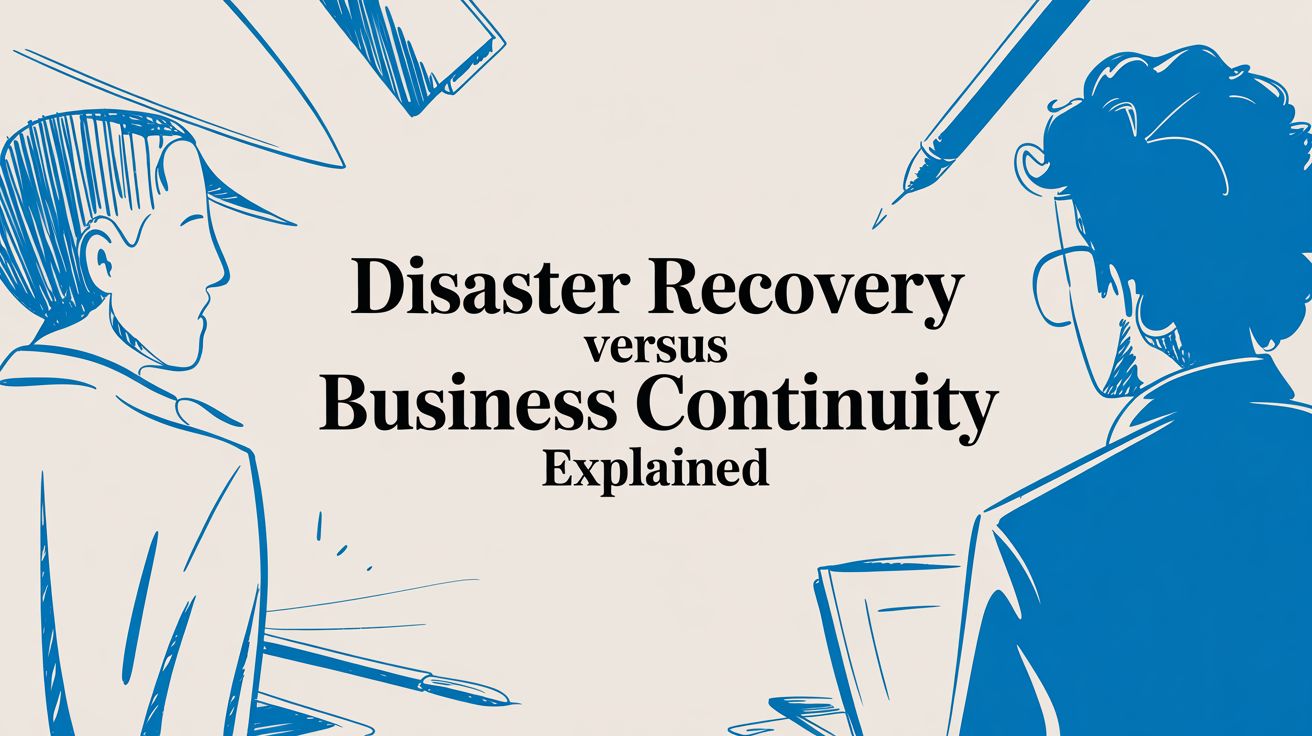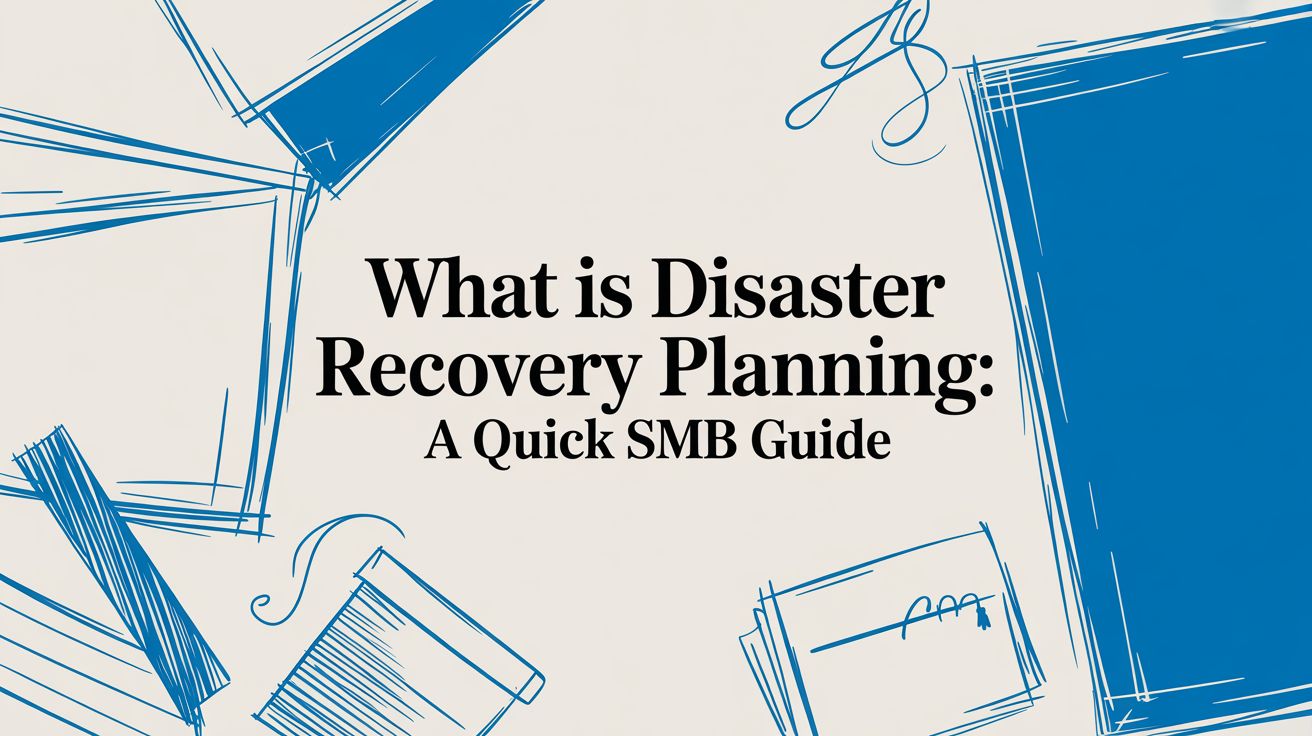Business Continuity Planning Checklist for Modern Businesses
For small and mid-sized businesses in Dallas and Memphis, operational disruptions are not just an inconvenience; they are a direct threat to your existence. A sudden ransomware attack, a regional power outage, or even a critical server failure can define the line between a temporary setback and a permanent closure. Many business leaders mistakenly believe a simple data backup is enough, but true resilience requires a holistic and proactive strategy.
This comprehensive business continuity planning checklist moves beyond abstract theory, providing ten actionable, non-negotiable steps. We will explore each critical element through the lens of a Managed IT Services partner, demonstrating how robust cybersecurity, modern cloud solutions, and strategic planning transform your business from vulnerable to unbreakable. Forget the "what ifs" and focus on the "how-tos." This guide provides the practical framework needed to ensure your operations remain online, your data stays secure, and your team is ready for anything. Let's build a plan that keeps your business running, no matter what comes your way.
1. Conduct a Comprehensive Risk Assessment and Threat Analysis
The foundation of any successful business continuity planning checklist is a thorough understanding of what could disrupt your operations. A comprehensive risk assessment is a systematic process for identifying, analyzing, and evaluating potential threats specific to your organization. This isn't about vague fears; it’s about a data-driven approach to pinpointing vulnerabilities in your technology, processes, and people.
This process involves quantifying both the probability of a threat occurring and the potential impact it would have on your business. By scoring risks this way, you can prioritize your mitigation efforts, focusing resources on the most likely and damaging scenarios first. For example, a Dallas-based logistics company might identify their on-premise dispatch server as a high-impact, single point of failure vulnerable to hardware failure. In contrast, a Memphis healthcare clinic might find that their patient data backup process isn’t encrypted, creating a critical compliance and cybersecurity vulnerability.
Actionable Steps:
- Involve all departments: Your operational risks extend beyond the server room. Involve heads from finance, operations, and HR to get a holistic view of potential disruptions.
- Analyze internal and external threats: Consider everything from hardware failure, human error, and cyber attacks to supply chain issues and severe weather events.
- Partner for a technical assessment: Working with a Managed IT partner like PWR Technologies provides an expert perspective on current cyber threats and infrastructure vulnerabilities that an internal team might miss. This ensures a technically sound foundation for your entire continuity plan.
2. Business Impact Analysis (BIA)
Following a risk assessment, the Business Impact Analysis (BIA) is where you quantify the specific consequences of a disruption. This process moves beyond identifying threats to precisely measuring how downtime affects your most critical business functions. A BIA determines the financial and operational impact over time, allowing you to prioritize recovery efforts based on which systems and processes are most vital to your survival.
This analysis is foundational to your entire business continuity planning checklist because it defines your recovery objectives. An e-commerce platform in Dallas might discover that one hour of downtime costs over $50,000 in lost sales and reputational damage. Meanwhile, a Memphis healthcare clinic could find that losing access to patient records for even 15 minutes creates significant operational and compliance risks. These real-world metrics drive the technical requirements for your continuity solutions, justifying investments in proactive IT and cloud infrastructure.

Actionable Steps:
- Interview process owners directly: Go beyond the IT department. Speak with leaders in sales, finance, and operations to understand their dependencies and the real-world impact of an outage.
- Calculate the full cost of downtime: Factor in not just lost revenue but also regulatory penalties, reputational damage, and the costs of remediation to get a true picture of the impact.
- Define RTO and RPO: Establish your Recovery Time Objectives (how quickly you must recover) and Recovery Point Objectives (how much data you can afford to lose) based on business needs, not just technical limitations. For more details on how these metrics shape your strategy, you can explore the differences between disaster recovery and business continuity.
- Review and update annually: Your business is not static. Revisit your BIA each year or after significant changes, like migrating to Microsoft 365 or expanding operations, to ensure your plan remains relevant.
3. Recovery Strategies Development
After identifying what could go wrong, the next critical step in a business continuity planning checklist is to define exactly how you will recover. Recovery Strategies Development is the process of designing and selecting specific technical and operational tactics to restore critical functions within your predetermined Recovery Time Objectives (RTOs) and Recovery Point Objectives (RPOs). This moves beyond the theoretical "what if" into the practical "how-to" of your response.
This stage involves matching the right solution to each critical business function, ensuring you don't overspend on non-essential systems or under-protect vital ones. For instance, a financial services firm in Dallas might require real-time data replication to a secondary cloud environment in Azure to meet near-zero RTO/RPO demands. In contrast, a professional services firm could leverage a cloud-based backup solution with daily snapshots for its project files, balancing cost with a slightly longer, yet acceptable, recovery window.
Actionable Steps:
- Match strategy to requirements: Design recovery solutions that align precisely with the RTO/RPO of each business function, not just the maximum technical capability. This prevents unnecessary expenses on overly complex systems.
- Consider geographic separation: To mitigate regional disasters like severe weather or power grid failures, ensure your cloud backups and recovery sites are located in a different geographic area from your primary operations.
- Document every procedure: Create detailed, step-by-step instructions for each recovery process. A comprehensive disaster recovery plan template can guide this documentation, ensuring clarity during a high-stress event.
4. Comprehensive Communication Plan
Technology and backups are only part of the equation; how you manage information during a crisis determines whether stakeholders maintain trust or lose confidence. A comprehensive communication plan is a structured framework for disseminating timely, accurate, and consistent information to all relevant parties during a disruption. It moves beyond a simple contact list to define who says what, through which channels, and at what time.
During a system outage or data breach, chaos can spread quickly. A predefined plan prevents misinformation and ensures employees, customers, vendors, and regulatory bodies receive the right message. For example, a client of ours in the financial services sector uses pre-approved templates to instantly notify clients about a service interruption via SMS and email, while their internal team receives updates on a dedicated Teams channel. This structured approach, a key element of any business continuity planning checklist, transforms a reactive panic into a controlled, professional response.

Actionable Steps:
- Segment your stakeholders: Create distinct communication protocols for internal teams, customers, suppliers, and regulatory agencies. A robust communication strategy is crucial during a disruption; learn more about actionable internal communication best practices to keep your team aligned.
- Establish redundant channels: Relying solely on company email is a critical mistake, as it may be unavailable during an outage. Your plan must include alternative methods like SMS alert systems, a dedicated status page on your website, or a cloud-based tool like Microsoft Teams.
- Develop message templates: Pre-craft initial statements and update templates for common scenarios like ransomware attacks, power outages, or cloud service failures. This dramatically speeds up response times and reduces the risk of error under pressure.
5. Testing and Validation Program
A business continuity plan is only a document until it's proven to work under pressure. A testing and validation program transforms your written strategy into a living, practical framework by regularly simulating disruptions to verify its effectiveness. This isn't just a pass-fail exercise; it’s a critical process for uncovering hidden gaps, building muscle memory within your team, and ensuring your recovery strategies are truly functional.
The goal is to move beyond theory and test the real-world applicability of your plan. A Memphis-based medical clinic we work with simulates a ransomware attack annually to test their backup restoration time and ensure they can failover to their secondary data center without violating HIPAA. Similarly, a Dallas professional services firm conducts quarterly tests of their remote work capabilities, confirming that all staff can access critical cloud applications securely after a simulated office closure. These exercises underscore the importance of validating every part of your business continuity planning checklist.

Actionable Steps:
- Establish a consistent testing cadence: Schedule tests quarterly for your most critical functions and annually for all others. This regularity prevents plan staleness and keeps your team prepared.
- Vary your scenarios: Avoid repeating the same test. Introduce new challenges like a supply chain failure, a key vendor outage, or a targeted cyber attack to assess the plan’s versatility.
- Test backups independently: A crucial part of your plan is data recovery. Partner with an IT provider like PWR Technologies to test your backup systems in isolation, ensuring a cascading failure in your primary systems doesn't also corrupt your recovery data. This provides a true measure of your resilience.
6. Employee Training and Awareness Program
A business continuity plan is only effective if your team knows how to execute it. A structured training and awareness program transforms a static document into a dynamic, living strategy. It ensures every employee, from the front desk to the executive suite, understands their specific roles and responsibilities during a disruptive event. This goes beyond a single annual memo; it's about building a resilient organizational culture.
This process involves regularly educating staff on the plan's fundamentals, including communication protocols, data handling procedures, and role-specific duties. For instance, a Dallas-based accounting firm would train its staff on how to securely access cloud-based financial systems from remote locations using multi-factor authentication. Meanwhile, a Memphis medical clinic would drill its team on manual charting procedures if the electronic health record system goes down. The goal is to make the response second nature, reducing panic and minimizing operational downtime during a real crisis.
Actionable Steps:
- Make training mandatory and role-based: All employees, including new hires within their first 30 days, must complete training. Use scenarios relevant to their specific jobs to make the information practical and memorable.
- Use diverse formats: Combine online modules, in-person workshops, and quick-reference materials like laminated cards or digital guides to accommodate different learning styles and increase engagement. To demonstrate the value of these efforts, it's critical to know how to measure training effectiveness and ROI.
- Focus on cybersecurity awareness: A well-trained employee is your first line of defense against cyber threats that can trigger a business disruption. Integrate topics like phishing identification and password hygiene into your program. A key part of this is teaching them how to protect against ransomware through vigilance and safe practices.
7. Data Backup and Recovery Procedures
A business continuity plan is only as strong as its ability to restore critical data after a disruption. Effective data backup and recovery procedures are the technical heart of your resilience strategy, ensuring that information is not just saved, but can be quickly and reliably restored to resume operations. This goes beyond simply running a nightly backup; it involves a documented, tested process for protecting data against corruption, deletion, and malicious attacks like ransomware.
This element of your business continuity planning checklist defines how often you back up data (Recovery Point Objective - RPO) and how quickly you can restore it (Recovery Time Objective - RTO). For a Dallas-area law firm, this might mean near-instantaneous failover for case management systems to meet client obligations. In contrast, a Memphis marketing agency might tolerate a four-hour RTO for creative files. A well-designed strategy, like the 3-2-1 rule (three copies, two different media, one off-site), is the gold standard for data protection and is a core component of any modern Managed IT Services offering.
Actionable Steps:
- Implement the 3-2-1-1 strategy: Maintain 3 copies of your data on 2 different types of media, with 1 copy stored off-site (in the cloud) and 1 copy that is immutable or air-gapped. This provides robust protection against both local disasters and ransomware.
- Test recovery, not just backups: Don't assume a successful backup notification means the data is usable. Conduct monthly or quarterly recovery tests to validate data integrity and confirm you can meet your RTO.
- Segregate and secure your backups: Store backups on a network segment separate from your primary production environment. This prevents ransomware from spreading and encrypting both your live data and your recovery copies. To explore robust options, you can learn more about small business data backup solutions that fit this model.
8. Supplier and Third-Party Continuity Management
Your business operations are not an island; they are deeply interconnected with an ecosystem of suppliers, vendors, and third-party service providers. A disruption to one of your critical partners can halt your operations just as effectively as an internal server failure. Supplier and third-party continuity management is the process of ensuring these external dependencies are as resilient as your own organization, protecting your entire value chain.
This involves proactively assessing the continuity readiness of your critical partners. For example, a medical practice that relies on a single vendor for its electronic health record (EHR) software must verify that the vendor has robust data backup and recovery plans. Similarly, a manufacturing firm needs to know that its sole component supplier has alternative production sites. This part of your business continuity planning checklist moves the focus from internal risks to your extended operational network, mitigating threats before they impact your customers.
Actionable Steps:
- Segment your suppliers: Categorize vendors based on their criticality. Focus your most intensive continuity efforts on Tier-1 suppliers whose failure would immediately stop your operations.
- Embed continuity in contracts: Include specific business continuity, disaster recovery, and cybersecurity requirements in your vendor contracts and requests for proposals (RFPs).
- Request and review their plans: Ask critical third-party partners for a copy of their business continuity plan. For key technology vendors, such as your cloud hosting provider or IT support, this is non-negotiable. Understanding what managed service providers do includes verifying their own redundancy and incident response protocols.
- Identify and qualify alternatives: Proactively identify and, where feasible, qualify at least one alternative supplier for mission-critical materials or services to enable a quick pivot during a disruption.
9. Incident Response and Activation Procedures
A plan is only effective if you know precisely when and how to activate it. Establishing clear incident response and activation procedures ensures that when a disruption occurs, your team can move from detection to action without hesitation or confusion. This involves creating a pre-defined framework for declaring a crisis, mobilizing the right teams, and maintaining control throughout the event.
This process removes ambiguity during high-stress situations by defining incident severity levels, escalation criteria, and decision-making authority. For instance, a system outage at a Dallas legal firm might be classified as a Severity 2 incident, triggering a specific playbook that mobilizes the IT recovery team. In contrast, a facility-wide power loss at a Memphis medical clinic would be a Severity 1, activating the full emergency operations center and backup power protocols immediately. This structured approach, inspired by modern cybersecurity frameworks, is a critical part of any effective business continuity planning checklist.
Actionable Steps:
- Define severity levels: Create an incident classification matrix with objective criteria for different severity levels (e.g., impact on revenue, number of users affected, data integrity risk) and publish it for all staff.
- Establish clear activation triggers: Keep activation procedures brief and unambiguous. Document the specific conditions that must be met to formally declare an incident and activate the business continuity plan.
- Create dedicated playbooks: Work with an IT partner like PWR Technologies to develop scenario-specific playbooks for common threats like ransomware attacks, server failure, or cloud service outages, detailing the exact technical and communication steps for each.
10. Plan Maintenance and Continuous Improvement
A business continuity plan is a living document, not a "set it and forget it" file. The goal of plan maintenance is to ensure your strategies remain effective as your business, technology, and the threat landscape evolve. Continuous improvement turns your plan from a static document into a dynamic operational tool that adapts to new challenges, ensuring its relevance and effectiveness when you need it most. This ongoing process is a critical part of any successful business continuity planning checklist.
Without regular updates, your plan quickly becomes obsolete. For example, a healthcare clinic in Memphis that migrates its patient management software to the cloud without updating its recovery procedures may find its entire plan unworkable during an outage. A formal maintenance cycle, often managed as part of a co-managed IT services agreement, transforms your plan from a theoretical exercise into a reliable, actionable guide for resilience.
Actionable Steps:
- Establish a formal review cycle: Schedule an annual review of the entire business continuity plan, ideally aligning with your strategic planning or budgeting process.
- Trigger reviews for major changes: Update the plan immediately following significant organizational shifts like a new office location, a major technology migration (such as moving to the cloud), or changes in key personnel.
- Document all changes: Maintain a version-controlled document with a detailed change log. This log should record what was changed, why it was changed, who approved it, and the date of the update.
- Integrate lessons learned: After every test, drill, or actual incident, conduct a post-mortem to identify what worked and what didn't. Feed these findings directly back into the plan to strengthen weak points.
- Partner for technical validation: Work with an IT partner like PWR Technologies to ensure your plan’s technical recovery steps align with your current infrastructure, security protocols, and backup solutions.
10-Point Business Continuity Checklist Comparison
Turn Your Checklist into an Action Plan with a Trusted IT Partner
Navigating the extensive business continuity planning checklist we've outlined is a significant achievement. You have moved beyond abstract concerns and now possess a structured framework for building true operational resilience. From conducting a thorough risk assessment and Business Impact Analysis (BIA) to establishing robust data backup protocols and a comprehensive communication plan, each item is a critical pillar supporting your organization's ability to withstand disruption. The key takeaway is that business continuity is not a static document; it is a living, breathing strategy that requires ongoing commitment.
The real challenge lies in transforming this checklist from a theoretical exercise into a practical, automated, and failsafe action plan. For small and mid-sized businesses, particularly those in regulated industries like healthcare or professional services, managing this process internally can be overwhelming. This is where the value of a dedicated IT partner becomes undeniable. An expert partner helps bridge the gap between knowing what to do and having the resources, technology, and expertise to actually do it effectively and consistently.
From Checklist to Confident Recovery
The most successful business continuity plans are not built in a vacuum. They are forged through a combination of strategic foresight and technical execution. Think about the most critical components of your plan:
- Data Backup and Recovery: Is your data being backed up securely, encrypted, and tested regularly? A Managed Services Provider (MSP) implements automated, multi-layered backup solutions (e.g., local, cloud, and off-site) and performs routine recovery drills to validate data integrity. This ensures that when you need your data back, it's available and uncorrupted.
- Cybersecurity and Incident Response: Your continuity plan is incomplete without a strong defense against cyber threats like ransomware. A proactive IT partner deploys advanced endpoint protection, 24/7 network monitoring, and a managed firewall to prevent incidents. If an attack occurs, their incident response team can isolate the threat, mitigate damage, and initiate recovery procedures immediately, minimizing costly downtime.
- Testing and Validation: A plan is only as good as its last test. We see many businesses create a plan and let it gather dust. An MSP institutionalizes testing by scheduling regular drills, from tabletop exercises to full failover simulations, ensuring your team knows exactly what to do and your technology performs as expected.
By leveraging an IT partner, you transition from simply having a business continuity planning checklist to embedding a culture of preparedness into your operations. You gain access to enterprise-grade tools, strategic guidance, and a dedicated team committed to your resilience. This allows you to focus on running your business, confident that a robust, tested, and professionally managed continuity plan is in place to protect you from the unexpected.
Don’t let your business continuity plan remain a document on a shelf. The experts at PWR Technologies LLC can help you implement, test, and manage every technical aspect of your checklist, from secure cloud backups to proactive cybersecurity. Contact PWR Technologies LLC today for a consultation and build a truly resilient future for your Dallas or Memphis-based business.




